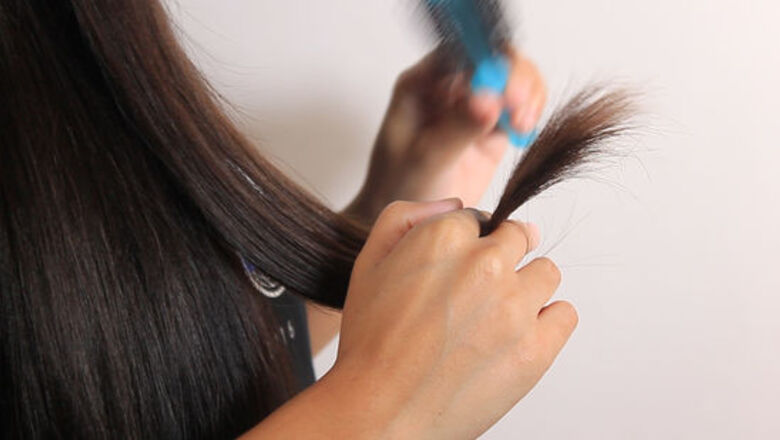
views
Twisting Your Hair
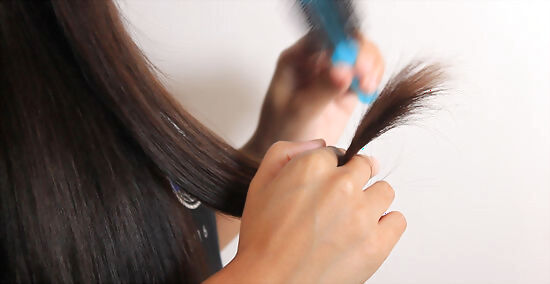
Separate a 1 inch (2.5 cm) section of dry hair after brushing it. It's helpful for your hair to be dry so that the split ends appear easily. Take a 1 inch (2.5 cm) section of your hair in your hands, taking time to brush it if it’s tangled. The section of hair doesn’t have to be exactly 1 inch (2.5 cm)—if your hair is thin, you might take a bigger section, while if your hair is super thick, you might take a smaller one. It’s best if you start on one side of your head so that you don’t get the sections of hair mixed up as you go along.
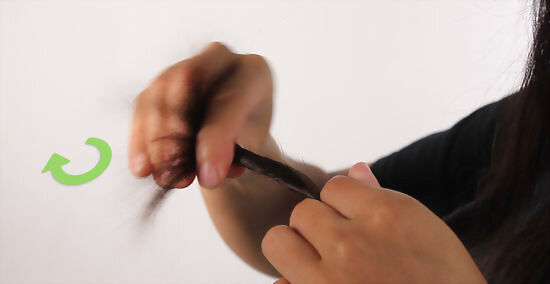
Twist the section of hair tightly to reveal the split ends. Start at the top of the section of hair, twisting it as you go down. Continue twisting the strand until the entire section is twisted rather tightly. Once the hair is twisted, you should see the ends of some strands popping up out of the twist.
Trim off the split ends that are sticking out of the twisted section. Examine the ends that are sticking out of the twist—most of them are likely to be split ends. Use the cutting shears to snip off about 0.5 centimetres (0.20 in) of each split end, revealing healthy hair. Cut off the split ends by starting from the top of the strand and going down. This will help ensure that you don’t miss any of them. If you have shorter hair that's more difficult to see, use a mirror when cutting off the split ends. Keep in mind that this will result in your hair being varied lengths. EXPERT TIP Courtney Foster Courtney Foster Licensed Cosmetologist Courtney Foster is a Licensed Cosmetologist, Certified Hair Loss Practitioner, and Cosmetology Educator based out of New York City. Courtney runs Courtney Foster Beauty, LLC and her work has been featured on The Wendy Williams Show, Good Morning America, The Today Show, The Late Show with David Letterman, and in East/West Magazine. She received her Cosmetology License from the State of New York after training at the Empire Beauty School - Manhattan. Courtney Foster Courtney Foster Licensed Cosmetologist Use sharp scissors to cut your split ends. Dull cutting instruments can actually cause more split ends. Which defeats the purpose of removing your current ends.

Re-twist the strand of hair going in the opposite direction, if desired. To reach even more split ends, undo the twist that you formed. Now start twisting the strand of hair the opposite way—this will help split ends become visible that didn’t appear during the first twist. Use the cutting shears to snip off these split ends as well. For example, if you twisted the strand of hair clockwise first, twist it counterclockwise the second time.

Gather a new section of hair and repeat the twisting process. Take a 1 inch (2.5 cm) section of hair next to the old section, twisting it like you did the first. Repeat the process of twisting it tightly and trimming off the ends that are sticking out, using sharp cutting shears to get a clean cut. Repeat this process until you’ve gone around your entire head, trimming individual sections. Use a hair clip or tie to hold back sections that you’ve already trimmed to avoid confusion.
Using the Sliding Technique
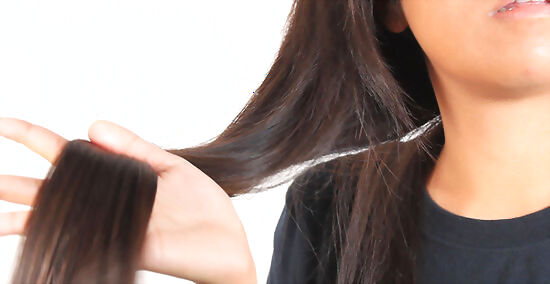
Style your hair so that it’s straight and dry. If you already have naturally straight hair, all you’ll need to do is brush through it thoroughly. If you have wavy or curly hair, it’s best to straighten it in addition to brushing it so that the split ends will pop up easier. If your hair is wavy, then you may need to just blow dry your hair, rather than using a straightener. If you’re using a hair straightener, remember to apply a heat protectant to avoid even more split ends!

Pull together a 1 inch (2.5 cm) section of hair. Use a small comb to section off your hair. 1 inch (2.5 cm) increments are just a suggestion—thick hair might require smaller sections, while super thin hair could handle a larger section. Use the comb to brush through the strand of hair again, if needed.

Position your hair in between your middle three fingers. Weave the strand of hair under your index finger, over your middle finger, and under your ring finger. By doing this, you should see your hair on top of your middle finger only. Position your fingers like this near the roots so that you’ll be able to slide your fingers down the strand.
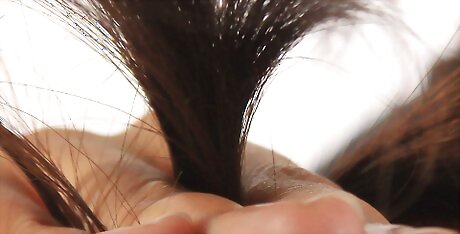
Look for the split ends that pop up when positioned over your finger. By weaving your hair in between your middle three fingers, you should see ends sticking out of the section of hair that’s visible on your middle finger. Look closely to spot split ends that need trimming. If your hair has layers, you’ll need to look extra closely to make sure the end sticking out is a split end and not just a shorter strand of hair. Use a mirror to help you spot the split ends if you can't easily see the strand of hair.

Clip off the split ends as you slide your fingers down the section of hair. Hold the scissors so that they're perpendicular to the strand of hair, making it easy to snip off the split ends that you see sticking out. Slide your fingers down the strand of hair slowly, continuing to clip off split ends as you go. You only need to clip off about 0.13 inches (0.33 cm) of hair.
Gather a new section of hair, repeating the same process. Pull together a new section of hair next to the one you just trimmed. Position your fingers the same way and start clipping off those split ends as you spot them. Do this process around your entire head, removing split ends while keeping your length. Use a hair clip or tie to clump together the sections of hair that you’ve already trimmed so that they’re out of the way. EXPERT TIP Courtney Foster Courtney Foster Licensed Cosmetologist Courtney Foster is a Licensed Cosmetologist, Certified Hair Loss Practitioner, and Cosmetology Educator based out of New York City. Courtney runs Courtney Foster Beauty, LLC and her work has been featured on The Wendy Williams Show, Good Morning America, The Today Show, The Late Show with David Letterman, and in East/West Magazine. She received her Cosmetology License from the State of New York after training at the Empire Beauty School - Manhattan. Courtney Foster Courtney Foster Licensed Cosmetologist Trim your split ends to keep your hair healthy. If you have too many split ends, the split can travel up your hair shafts and cause breakage.
Trimming the Ends
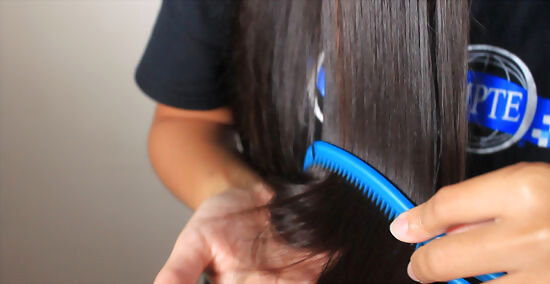
Brush your dampened hair thoroughly to remove any tangles. Use a brush with natural bristles, or a metal comb if preferred. While it’s more useful to wet your hair beforehand no matter which type of hair you have, it’s definitely necessary for wavy or curly hair so that it straightens out as you’re brushing it. Your hair doesn’t need to be soaking wet, just damp. Try running your brush under the water before brushing your hair to help distribute the water. If you have textured hair, it's best to cut your hair when it's dry. It won't straighten when it's wet.

Use a small comb to separate a section of hair. Once your hair has been brushed through, use a small comb to gather a 1 inch (2.5 cm) section of hair. Start on one side of your head so that you can keep track of which sections you’ve already cut.
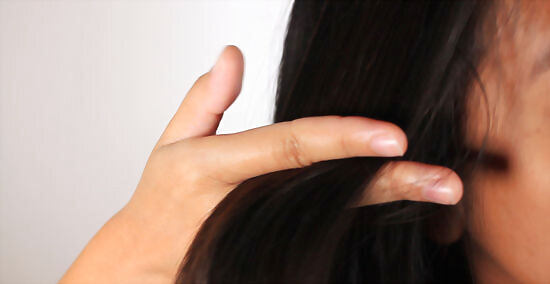
Slip the section of hair in between your index and middle finger. Starting towards the top of the section of hair, put the section in between your index finger and middle finger so that your fingers are holding the strand tightly. You can use any other fingers if desired—it’s most important that the strand of hair is pulled straight.

Slide your fingers down the section of hair towards the bottom. This will keep the section of hair straight, allowing you to get an accurate picture of what your ends look like. Stop sliding your fingers after there’s only about 1 inch (2.5 cm) of hair left at the end. As you’re sliding your fingers down the strand of hair, try to pull the strand away from your neck and out in front of you. This will allow you to cut the strand more easily.
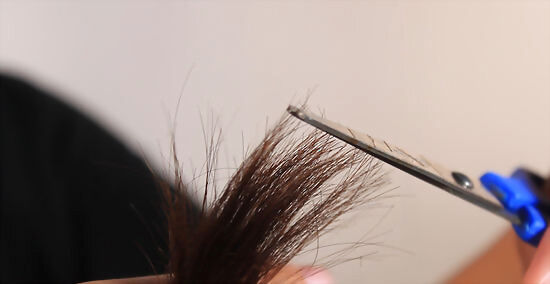
Cut 0.4–0.8 inches (1.0–2.0 cm) off the ends of the section of hair. Make the cut perpendicular to the strand of hair so that you get an even cut. If you have split ends that go far up the hair shaft, you may have to cut more than 0.8 inches (2.0 cm). Start by cutting off a small amount, just to be safe. You can always cut off more, if necessary.

Move to the next section of hair, repeating the process. Section off another 1 inch (2.5 cm) section of hair, trimming the ends perpendicular to the strand just as before. Use the previous section as a guide for cutting the proper length. Continue trimming the ends all around your head, giving yourself an even cut. Have someone help you with the back of your head, if possible. Use a hair tie or clip to separate hair that needs to be trimmed from hair that has already been trimmed to avoid confusion.
Preventing Split Ends

Moisturize your hair with conditioner often and effectively. After shampooing your hair, don't forget to use conditioner, taking time to massage the conditioner onto your ends. Hair can split and break for a number of reasons, but often it's because the hair isn't properly moisturized. Use a conditioner every time you shampoo for best results. You can also use a daily leave-in conditioner to moisturize your hair even on days that you don't shampoo it.

Use deep treatments for your hair weekly. Give your hair a little boost at least every week or so by doing a deep treatment. Deep treatments will give your hair more moisture and protection, so that if you go 2-3 days without shampooing and conditioning, your hair is sure to retain a lot of moisture.

Limit your use of heat tools. Even if you apply a heat protectant, tools such as curling irons or hair straighteners will still take a toll on your hair. While it's okay to use these tools sometimes, try not to use heat appliances on your hair every single day. If you're using the blow dryer, put it on the lowest setting to cause less damage. Always apply a heat protectant to your hair before using a heat tool.

Brush your hair using a wide tooth comb. A wide tooth comb is less likely to damage your hair and is great for detangling. It's especially important to use a wide tooth comb if you're brushing through wet hair, as wet hair is more likely to break and cause split ends.
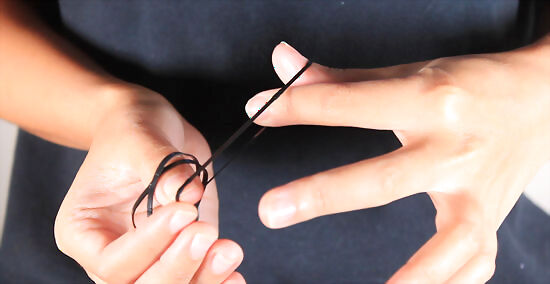
Opt for softer hair ties to tie your hair up with. If you're using hair ties that are super tight and rough on your hair, this might be a cause of split ends. Look for softer elastic hair ties that stretch well and don't pull on your hair. You can even make your own hair ties using a piece of elastic.

Get a trim every 8-12 weeks to keep your hair healthy. The longer you leave split ends, the more likely they are to climb up your hair shaft. By getting the ends trimmed every couple of months or so, you'll greatly reduce the likelihood of damaged hair. If you chemically treat your hair, then it's especially important that you get regular trims.




















Comments
0 comment